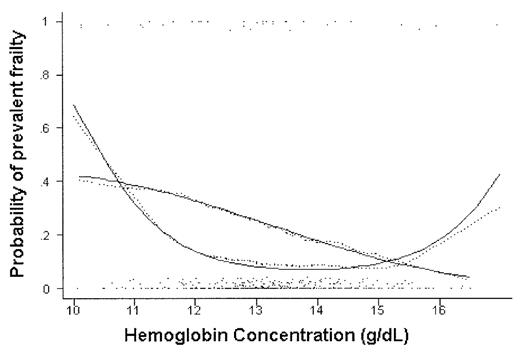Abstract
Background: Moderate-to-severe anemia has been shown to adversely affect health outcomes in patients with cardiovascular disease (CVD). Less is known about the potential conjoint impact of mild anemia and CVD on frailty status in community-dwelling older adults. The objectives of this cross-sectional study were two-fold: (1) to assess the risk of frailty associated with mildly low Hb in community-dwelling older women with and without CVD, and (2) to test whether the association between Hb and frailty differed according to CVD status.
Methods: Data from women 70–80 years old who participated in the baseline assessments of the Women’s Health and Aging Studies (WHAS) I and II were analyzed. Analysis was restricted to those with Hb >/= 10g/dL, and known frailty and CVD status. CVD was defined as angina, myocardial infarction, and/or congestive heart failure. Frailty was defined according to previously validated criteria; i.e., 3 or more of the following: slowness (walking speed<20th percentile), unintentional weight loss >10%, weakness (grip strength <20th percentile), low energy expenditure (bottom 20th percentile of Kcal estimated using the Specific Activity Scale), and self-reported low energy. A fully-adjusted logistic regression model that controlled for demographics, diseases (including depression), renal function and cognition was used to determine the probability of being frail as a function of Hb and/or CVD.
Results: In the analytic sample of 670 community-dwelling older women, 14% were frail, 12.8% had WHO-defined anemia (Hb <12 g/dL), 23.6% had CVD, and 17.1% had both anemia and CVD. Those with CVD were more likely to have anemia, though statistical significance was only borderline (OR 1.6, 95%CI 1.0–2.5, p=.077). Both anemia and CVD were independently associated with frailty in the fully-adjusted model (respectively, OR 2.3, 95%CI 1.1–4.8; and OR 2.2, 95%CI 1.2–4.2). When Hb was treated as a continuous variable, even mildly low Hb such as 11.5 g/dL (OR 3.0; 95%CI 1.5–6.0, p=.002), and low-normal Hb such as 12.5 g/dL (OR 1.3; 95%CI 1.0–1.8, p=.044) were independently associated with frailty, as compared to mid-normal Hb such as 13.5 g/dL. The relationship between frailty status and Hb varied according to CVD status (p-value for multiplicative interaction <.035) (Figure below).
Conclusion: In community-dwelling older women, mildly-low/low-normal Hb and CVD were independently associated with frailty status. More importantly, presence of both of these risk factors was associated with a synergistic increase in frailty risk above that expected on the basis of their independent effects. These results are particularly relevant for the development of novel screening and intervention approaches to prevent frailty in older adults.
Author notes
Corresponding author


This feature is available to Subscribers Only
Sign In or Create an Account Close Modal